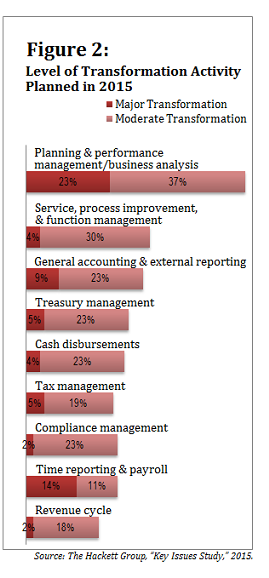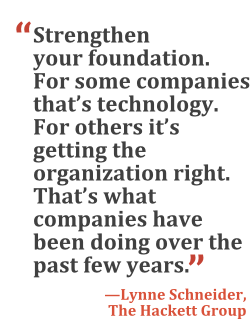 Despite all the talk of finance's evolution into a more strategic partner to the business, budgets and staffing remain quite tight. This dichotomy between expanding responsibilities and shrinking budgets is one of the key challenges revealed in this year's “Finance Key Issues” study from The Hackett Group. The two issues that survey respondents identified as most important in 2015 are Achieving and maintaining a competitive cost structure and Improving decision-making effectiveness.
Despite all the talk of finance's evolution into a more strategic partner to the business, budgets and staffing remain quite tight. This dichotomy between expanding responsibilities and shrinking budgets is one of the key challenges revealed in this year's “Finance Key Issues” study from The Hackett Group. The two issues that survey respondents identified as most important in 2015 are Achieving and maintaining a competitive cost structure and Improving decision-making effectiveness.
“Overall, when we talk to business leaders outside of finance, growth is at the top of the agenda,” says Jim O'Connor, global practice leader, global business services and finance advisory programs, for The Hackett Group. “Senior management is looking at growth through innovation, through new products and services, or through expanding into new regions. And so finance is focusing on building the capabilities they need to support the company's expected growth.”
At the same time, O'Connor recognizes, finance managers continue to face pressure to cut costs. “It's a duality in objectives,” he says. “As finance is finding ways to be a partner to the business and bring more value, they are also expected to operate with less, to trim staff, and to maintain a competitive cost structure.”
Pain Points in Finance Budgets and Staffing
More than two in five respondents to the “Key Issues Study” (41 percent) expect their finance function's budget to decline over the next year. On average, respondents' finance budgets grew by 0.8 percent in 2013 to 2014, but the typical respondent believes finance's operating budget will shrink by 0.1 percent in 2014 to 2015. Respondents also expect the finance function's staffing level to shrink. The average company's finance staffing fell by 0.5 percent in 2013-2014, and it's expected to fall by another 0.7 percent in 2014-2015. (See Figure 1, below.)
“One of the interesting parallels between last year and this year is that the budget is doing better than the staffing numbers,” says Lynne Schneider, senior research director for The Hackett Group. “We found that around 20 percent of organizations are seeing a staffing increase, but 46 percent expect to see a decline in their FTEs [full-time equivalent employees]. Many finance teams are getting a dynamic of more resources per FTE as they shift to providing more value-added services.”
It makes sense that a finance team which has become more strategic by automating formerly manual processes may be able to accomplish more with a smaller staff. But Hackett's findings make clear that the transition is far from painless.
 “As a finance organization changes, and puts more and more of the transactional activities into outsourcing or shared services, management needs to realign staff to meet the function's charter as a retained finance organization,” O'Connor says. “For example, consider what happens if you redesign processes and put in a treasury management system. Maybe before, you rewarded treasury staff when they knew where to get the right data and how to model it; data analysis was their world. But now you may be asking the same people to go out and partner with the business, to see if they can improve the short-term cash flow forecast. And that's a completely different skill set.
“As a finance organization changes, and puts more and more of the transactional activities into outsourcing or shared services, management needs to realign staff to meet the function's charter as a retained finance organization,” O'Connor says. “For example, consider what happens if you redesign processes and put in a treasury management system. Maybe before, you rewarded treasury staff when they knew where to get the right data and how to model it; data analysis was their world. But now you may be asking the same people to go out and partner with the business, to see if they can improve the short-term cash flow forecast. And that's a completely different skill set.
“Helping your people evolve, or outright changing some of your people, is a real challenge,” he adds. “I think most companies are not where they'd want to be with that, particularly around some of the higher-end business partnering skills. It's an issue companies need to deal with.” In fact, when respondents rated their confidence in their company's ability to meet an assortment of objectives, they gave the second-lowest rating to Align talent and skills to achieve enterprise's goals.
Overcoming this challenge requires a lot more than a simple training program. “'Talent management systems' is a buzzword right now, but it's something companies need to be focusing on,” O'Connor says. “In addition to training, there's leadership development, there's development of career paths, and there's up-front recruiting and hiring. This has been one of the hottest areas in finance over the past three years.”
Planning and Analytics Need Work
In addition to staffing issues, the Hackett report shows that finance organizations are having difficulty optimizing their IT systems. The only objective that respondents said their company is less able to meet than aligning talent with corporate goals was Maximize return on existing technology.
“Companies are unwilling to move away from the huge ERP systems they've implemented,” says Schneider. “They're not going to walk away from those investments, so they're putting a lot of small, mobile-enabled layers on top of them, hoping to get a tool they can use a lot.”
 This approach may not be adequate. Respondents are not confident in their company's ability to Integrate planning processes and data between finance and other operational areas. Nor do they feel good about finance's ability to Improve analytical, modeling, and reporting capabilities. To put these findings into context, O'Connor says, consider this: “When you're looking to align your planning with the operational areas, do you have—for example—one consistent volume forecast? Is it aligned across marketing, finance, and the supply chain? What about your financial forecasts and your capital structure?” He thinks most companies are doing well, or at least fine, on the mechanics of financial reporting. Where many need improvement is in modeling and financial analytics.
This approach may not be adequate. Respondents are not confident in their company's ability to Integrate planning processes and data between finance and other operational areas. Nor do they feel good about finance's ability to Improve analytical, modeling, and reporting capabilities. To put these findings into context, O'Connor says, consider this: “When you're looking to align your planning with the operational areas, do you have—for example—one consistent volume forecast? Is it aligned across marketing, finance, and the supply chain? What about your financial forecasts and your capital structure?” He thinks most companies are doing well, or at least fine, on the mechanics of financial reporting. Where many need improvement is in modeling and financial analytics.
The good news is that nearly two-thirds of respondents (60 percent) expect their company's planning, performance management, and business analysis processes to undergo a major or moderate transformation in 2015. (See Figure 2, at left.) This result continues a trend, O'Connor says. “Improved planning, performance management, and business analysis have consistently been the highest priority over the past three to five years.” Why? “This is probably the area that has the most constituents external to finance,” he adds. “If I'm in retail, for example, the head of merchandising is demanding better information, and quick. And much of that information comes from finance.”
The finance capability that Hackett found to be second-most-likely to experience a major transformation in 2015 is time reporting and payroll—“another area with a lot of external pressure,” Schneider points out. Fourteen percent of respondents expect their company to undergo a major transformation of time reporting and payroll this year, while only 5 percent hold the same expectation for treasury management processes.
“If treasury is doing an adequate job, the rest of the business is unlikely to be clamoring to do a better job of treasury management,” Schneider explains. “But business intelligence and performance management are processes with a lot of constituents outside of finance, so they're areas where finance gets continuous pressure from other executives.”
Finance Transformation Built on a Strong Foundation
Although many finance teams are struggling to meet some of the expectations of their firm's business leaders, those expectations can themselves be seen as evidence of the expanded capabilities of the finance organization. “A few years ago, general accounting and external reporting were the areas in which companies were undergoing the most transformation,” Schneider says. “People were trying to get that base data right. Until they got that foundation standardized across the company, they couldn't make anything out of higher-level data analysis.
 “Time and time again we come back to the phrase 'Strengthen your foundation,'” she adds. “For some companies that's technology. For others it's getting the organization right. And that's what companies have been doing over the past few years.”
“Time and time again we come back to the phrase 'Strengthen your foundation,'” she adds. “For some companies that's technology. For others it's getting the organization right. And that's what companies have been doing over the past few years.”
In the study's rankings of the importance of key finance issues, we've noted that first and second place went to building a competitive cost structure and improving decision-making. Meanwhile, Improving cash flow and balance sheet got third place. As O'Connor puts it: “When we talk about operational finance, we often want to talk about strategy and decision-making. But the fact is, managing cash flows, the balance sheet, and enterprise risk, and optimizing capital structure to support the business ranked pretty high.”
As finance teams evolve into business partners and transform the processes that other executives rely on most heavily, finance executives realize that treasury and other traditional finance tasks remain crucial to success. “You have to strengthen the foundation,” O'Connor says, “with an eye on how that can contribute to growth. Risk, governance, the capital structure, and making sure you have good cash flow and a strong balance sheet—doing well in all these areas gives the CFO confidence that you know where you're going to be however things may turn in other areas of the business.”
© 2025 ALM Global, LLC, All Rights Reserved. Request academic re-use from www.copyright.com. All other uses, submit a request to [email protected]. For more information visit Asset & Logo Licensing.




